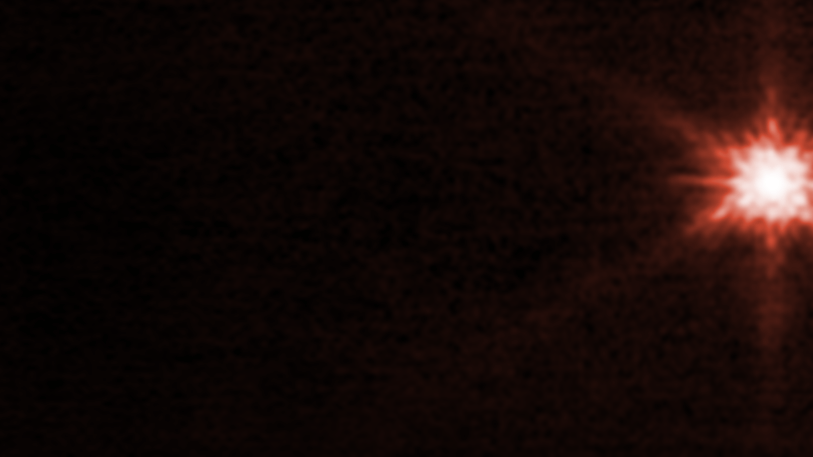
James Webb Space Telescope pushed past its limits to observe DART asteroid crash (Image Credit: Space.com)
The James Webb Space Telescope had to perform outside of its design limits to observe the collision of NASA’s DART probe with the asteroid moonlet Dimorphos in September last year, NASA has revealed.
Writing in a blog post, NASA’s James Webb Space Telescope deputy project scientist Stefanie Milam, of the Goddard Space Flight Center in Maryland, revealed that scientists had to go to great lengths to enable the grand telescope to watch the historic space rock deflection test.
On September 26, 2023, after a ten-month journey in space, the 1,260-pound (570 kilograms) Double Asteroid Redirection Test (DART) probe smashed into the 620-foot-wide (190 meters) asteroid moonlet Dimorphos to change its orbit around a larger rock called Didymos. The experiment was the first of its kind, designed to prove that humans could alter the trajectory of an asteroid if one was to threaten our planet in the future. The impact and its aftermath were observed by countless telescopes from Earth as well as in space, and Webb simply couldn’t skip the party.
Related: The James Webb Space Telescope just found an asteroid by total accident, its smallest object yet
Built primarily to observe the most distant objects in the universe, Webb was, prior to its launch, tested to follow only rather slow moving objects, Milam wrote in the blog post (opens in new tab). The fastest-moving body astronomers expected to track with Webb was Mars, which saunters across the sky at a speed of about 30 milliarcseconds per second (an arcsecond is 1/60 of an arc minute, which is 1/60 of a degree). That means that Mars crosses the width of a full moon as observed from Earth in about 17 hours.
But the near-Earth Didymos/Dimorphos asteroid duo was only about 6.8 million miles (11 million kilometers) from our planet during the DART impact, 24 times closer than the average Mars-Earth distance. And therefore, it appeared to hurtle across the sky much faster. At more than 100 milliarcseconds per second, DART traveled at more than three times Webb’s designed tracking speed and that was certain to pose a challenge.
Webb uses its Fine Guidance Sensor (FGS) to track moving objects it wants to image. FGS is a special camera that can lock onto reference stars, also called guide stars, to stay focused on a target with respect to its surroundings. When objects move too fast for Webb, the guidance sensor has to skip from one guide star to another to maintain the target in focus, which is technically demanding. Fortunately, it wasn’t necessary to image Dimorphos for a long period of time during the DART impact.
Prior to the planned collision, the Webb team practiced high-speed tracking on a couple of other near-Earth asteroids, including the space rock 2010 DF1, which at 90 milliarcseconds per second was moving in the sky nearly as fast as Dimorphos.
“If we could successfully track this asteroid, we knew we could track the DART impact event,” Milam wrote in the blogpost. “We were down to the wire with tests being done only two weeks prior to the date of the DART impact into Dimorphos!”
Thanks to all these preparations, Webb’s Near-Infrared Camera (NIRCam) managed to capture an exquisite sequence of images capturing the DART impact and its aftermath, which revealed how material from the tiny asteroid moonlet spread into the surrounding space like an enormous plume.
The observations will help astronomers understand what Dimorphos is made of and how to optimize a possible future asteroid deflection operation if one is ever needed.
Webb wasn’t the only space telescope observing the first-of-a-kind experiment. The older Hubble chipped in too. And DART, in fact, traveled to the Didymos/Dimorphos binary asteroid in the company of a personal photographer; the Italy-built LICIACube, captured images of the impact aftermath from a cosmically short distance of only 600 miles (1,000 kilometers).
As for Webb, the DART imaging campaign enabled astronomers to increase the telescope’s tracking speed limit to 75 milliarcseconds per second. The team might consider faster observations on a case by case basis.
Follow Tereza Pultarova on Twitter @TerezaPultarova (opens in new tab). Follow us on Twitter @Spacedotcom (opens in new tab) and on Facebook (opens in new tab).





